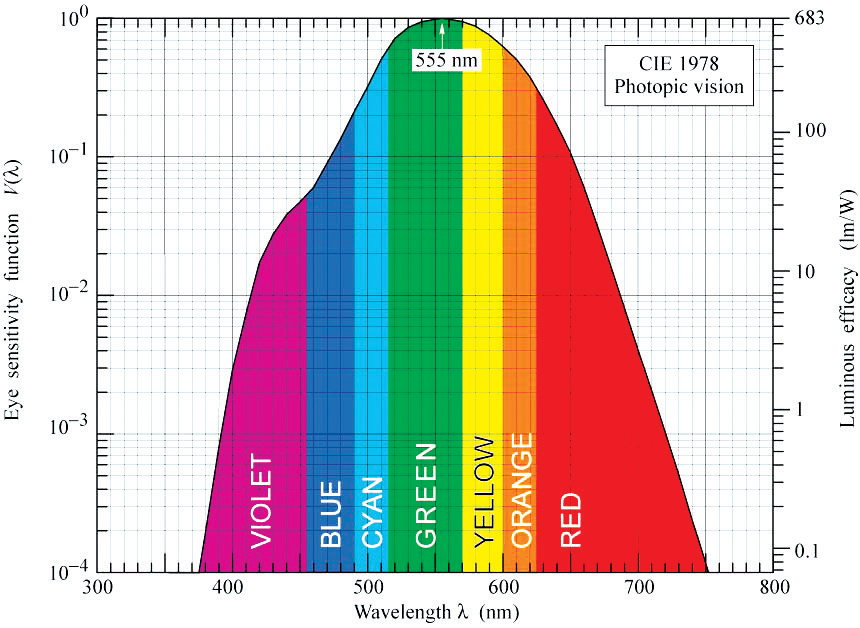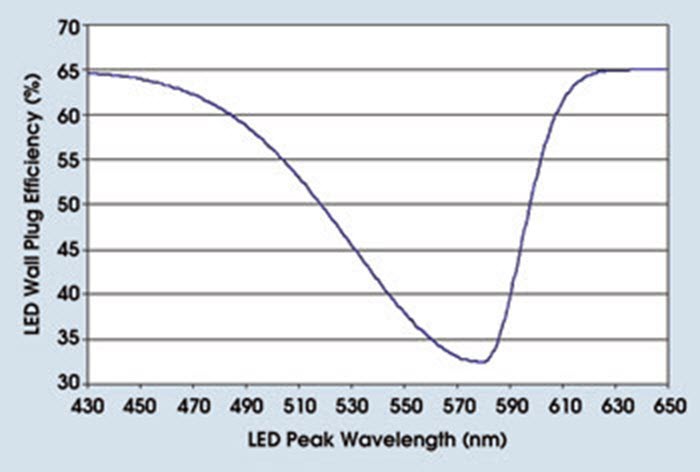As mentioned earlier, fluorescent lamps attempted to address their color spectrum limitations through the addition of newer and more complex phosphors targeted to produce additional color wavelengths. LEDs have another option given their naturally monochromatic nature through the addition of more LEDs engineered to output desired wavelengths1. However, this method has challenges associated with the efficacy of different LED sources to produce light as perceived by the human eye. This design comes under the header of color-mixing LEDs (where LED light emission is the only source), and hybrid-LED designs (where one or more color-mixing LEDs are combined with phosphor-coated LEDs). Though both designs merit further discussion to understand their place in the present and future of white light LEDs, the role of the human eye in color perception also deserves examination.
Earlier the low efficacy of filament light sources was demonstrated by highlighting their tendency towards producing energy in wavelengths invisible to the human eye (particularly as infrared heat energy). Wavelengths of visible light are not, however, all perceived with similar levels of sensitivity by the human eye nor are their means of production using semiconductor sources equally efficient. Just as CRI establishes the conformance of a light source of a given temperature to color rendering associated with an incandescent source, the luminous efficiency function (or eye sensitivity function) demonstrates that the eye has significantly different responses to each of the wavelengths of the visible spectrum. This sensitivity peaks at the green 555 nm wavelength. As expressed in luminous efficacy, it demonstrates that an ideal monochromatic source (excluding all other losses) could have a peak luminous efficacy of 683 lumens per watt. See the figure below for a chart of eye sensitivity.
Of course, a monochromatic source would score some 0 CRI and as such be unsuitable for general lighting. However, it is this curve which high efficiency sources are exploiting by combining peaks in the blue and red regions, where the eye is less sensitive, to combine and produce a light which both appears white while providing suitable efficiency. Early fluorescent lamps did just that, producing high luminous efficacy while outputting only two primary wavelengths. Thus, they also suffered from the limited CRI possible with such a combination. Balancing high efficacy with acceptable CRI is the primary challenge for lighting such as fluorescents and LEDs (whose emissions and/or phosphors often exhibit emission in defined wavelengths rather than as a continuous spectrum as with incandescent light sources).
LEDs seem an obvious candidate for mixing together different colors without suffering the energy losses associated with phosphors, but significant differences in efficiency exist today among LEDs operating at different wavelengths along the visible spectrum. The least efficient LED designs are those engineered to output at or near the 555nm peak eye sensitivity wavelength referenced earlier. This is commonly known as the green-gap (see the figure below) and is one of the reasons why phosphor-coated systems have prevailed over color-mixing only designs to date. While blue LEDs have achieved power conversion efficiencies of 60% and greater, red, green, and amber sources have been limited to 44%, 22%, and 8% respectively2.
 |  |
| The normalized eye sensitivity chart also expressed as luminous efficacy.1 | LED efficiency as a function of wavelength.3 Contrast the trough in this curve with the peak in the chart to the left. |
Collectively these factors help to explain the popularity of the dominant LED system design based upon blue light LEDs. They also could be seen to recommend the approach we've taken to incorporate commodity white lamps rather than build a color mixing solution one wavelength at a time. Of course, integrating a color spectrometer will enable some level of understanding as to what any given light source we've selected contributes towards its part of the color spectrum. Ideally we should be able to leverage the optimizations present in low-cost LED light sources while producing a light system greater than the sum of its parts.
1 Schubert, Fred. Light Emitting Diodes. 2nd ed.
2 “The Prospects for Creating Efficient Color-Mixed White LEDs.” SSL Postings, 16 June 2015, energy.gov/sites/prod/files/2015/06/f23/postings_06-16-15.pdf.
3 Bretschneider, Eric. “Efficacy Limits for Solid-State White Light Sources.” Photonics Media, Photonics Media, 10 Jan. 2014, www.photonics.com/Article.aspx?AID=28677.
 Jon
Jon
Discussions
Become a Hackaday.io Member
Create an account to leave a comment. Already have an account? Log In.